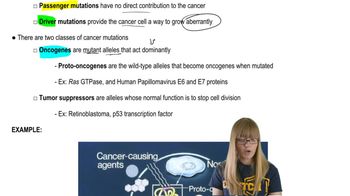Table of contents
- 1. Introduction to Genetics51m
- 2. Mendel's Laws of Inheritance3h 37m
- 3. Extensions to Mendelian Inheritance2h 41m
- 4. Genetic Mapping and Linkage2h 28m
- 5. Genetics of Bacteria and Viruses1h 21m
- 6. Chromosomal Variation1h 48m
- 7. DNA and Chromosome Structure56m
- 8. DNA Replication1h 10m
- 9. Mitosis and Meiosis1h 34m
- 10. Transcription1h 0m
- 11. Translation58m
- 12. Gene Regulation in Prokaryotes1h 19m
- 13. Gene Regulation in Eukaryotes44m
- 14. Genetic Control of Development44m
- 15. Genomes and Genomics1h 50m
- 16. Transposable Elements47m
- 17. Mutation, Repair, and Recombination1h 6m
- 18. Molecular Genetic Tools19m
- 19. Cancer Genetics29m
- 20. Quantitative Genetics1h 26m
- 21. Population Genetics50m
- 22. Evolutionary Genetics29m
19. Cancer Genetics
Cancer Mutations
Problem 26
Textbook Question
A study by Bose and colleagues [(1998). Blood 92:3362–3367] and a previous study by Biernaux and others [(1996). Bone Marrow Transplant 17:(Suppl. 3) S45–S47] showed that BCR-ABL fusion gene transcripts can be detected in 25 to 30 percent of healthy adults who do not develop chronic myelogenous leukemia (CML). Explain how these individuals can carry a fusion gene that is transcriptionally active and yet do not develop CML.
 Verified step by step guidance
Verified step by step guidance1
<span>Step 1: Understand the BCR-ABL fusion gene. The BCR-ABL fusion gene is a result of a translocation between chromosome 9 and chromosome 22, known as the Philadelphia chromosome. This fusion gene encodes a tyrosine kinase protein that is constitutively active, leading to uncontrolled cell division.</span>
<span>Step 2: Recognize the role of the BCR-ABL fusion gene in CML. In chronic myelogenous leukemia (CML), the BCR-ABL fusion protein is a key driver of the disease, as it promotes the proliferation of myeloid cells.</span>
<span>Step 3: Consider the presence of BCR-ABL in healthy individuals. Studies have shown that BCR-ABL transcripts can be detected in a significant percentage of healthy adults, suggesting that the presence of the fusion gene alone is not sufficient to cause CML.</span>
<span>Step 4: Explore additional factors required for CML development. The development of CML likely requires additional genetic or environmental factors beyond the presence of the BCR-ABL fusion gene. These could include other genetic mutations, epigenetic changes, or immune system factors that contribute to the progression to leukemia.</span>
<span>Step 5: Conclude with the concept of genetic predisposition versus disease manifestation. The presence of a genetic abnormality like the BCR-ABL fusion gene may predispose individuals to certain conditions, but without the necessary additional factors, the disease may not manifest. This highlights the complexity of genetic diseases and the interplay of multiple factors in disease development.</span>
Recommended similar problem, with video answer:
 Verified Solution
Verified SolutionThis video solution was recommended by our tutors as helpful for the problem above
Video duration:
1mPlay a video:
Was this helpful?
Key Concepts
Here are the essential concepts you must grasp in order to answer the question correctly.
BCR-ABL Fusion Gene
The BCR-ABL fusion gene results from a chromosomal translocation between the BCR gene on chromosome 22 and the ABL gene on chromosome 9. This fusion creates a hybrid protein that has tyrosine kinase activity, which can lead to uncontrolled cell proliferation. However, the presence of this gene alone does not guarantee the development of chronic myelogenous leukemia (CML), as other genetic and environmental factors also play a crucial role in disease manifestation.
Recommended video:
Guided course

Mapping Genes
Transcriptional Activity
Transcriptional activity refers to the process by which a gene is expressed to produce RNA, which can then be translated into proteins. In the case of the BCR-ABL fusion gene, it can be actively transcribed in some individuals without leading to CML. This suggests that while the gene is present and functional, additional mutations or regulatory mechanisms may be necessary for the progression to leukemia.
Recommended video:
Guided course

Eukaryotic Transcription
Genetic and Environmental Factors
The development of diseases like CML is influenced by a combination of genetic predispositions and environmental factors. While the presence of the BCR-ABL fusion gene is a significant risk factor, not all individuals with this gene develop CML. Factors such as additional genetic mutations, immune system status, and exposure to certain environmental triggers can determine whether an individual progresses to leukemia despite having an active fusion gene.
Recommended video:
Guided course

F Factor and Hfr

 4:50m
4:50mWatch next
Master Cancer Mutations with a bite sized video explanation from Kylia Goodner
Start learningRelated Videos
Related Practice


